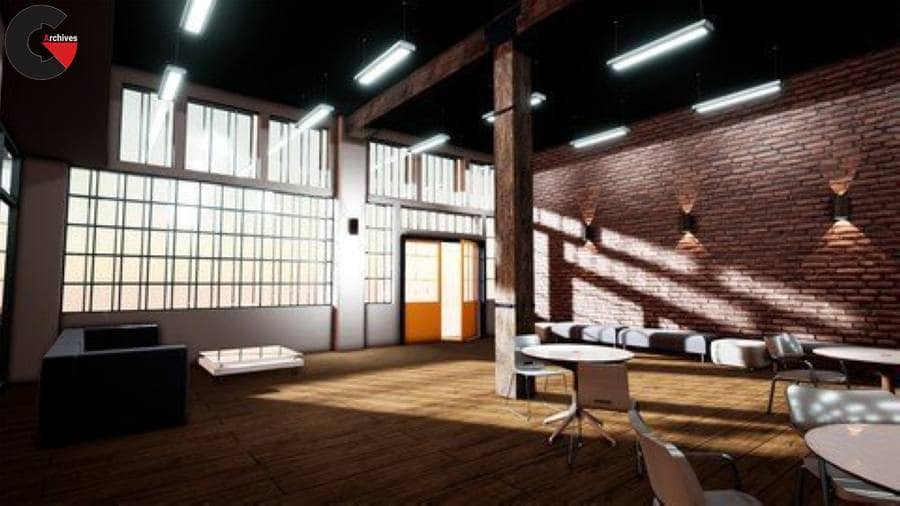

Unreal Engine : Architectural Visualization :
Requirements
- Unreal Engine
- You must have the skills for using Unreal Engine at an intermediate level
1- Revit to Unreal for Architecture, Visualization and VR
Intermediate
Section 1 – 7
Revit, 3ds Max, and Unreal are major players in the architecture, visualization, and virtual reality worlds. These technologies allow you to immerse yourself in designs—before you ever build them. Find out how to make these tools play well together to bring your own models to life. Instructor Simon Manning shows how to prepare your Revit projects for export, import them in Unreal, and use the Datasmith Product Viewer template to leverage prebuilt interactive elements such as furniture and lights. Then find out how to create and apply custom materials and adjust the lighting of your model. Simon also shows how to add interactions with Blueprint scripting and package your visualizations for display on VR headsets or mobile devices. Using these tutorials, you can polish your Revit models into interactive presentations that you can’t wait to share with clients.
2- Unreal Engine: ArchViz Design Techniques
Intermediate
Section 8 – 11
Want to work faster and smarter in Unreal Engine? In this course, pick up practical architectural visualization techniques that can help you build compelling experiences with Unreal Engine. Instructor Simon Manning shares tips for working with materials, including how to get realistic mirrors in your scene and give your glass materials reflectivity. He also explores how to regenerate improved lightmaps from within Unreal, as well as how to reduce draw calls and poly counts, measure project performance, and more.
3- Unreal: Substance Designer Workflow
Intermediate
Section 12 – 16
Explore the integration of Substance Designer—a powerful tool for creating textures for 3D art, visualization projects, and games—with Unreal Engine. This course provides a solid foundation of the principles of texture creation in Substance Designer for use in Unreal Engine. Instructor Scott Pagano explains how to import a model into Substance Designer and bake AO, curvature, and ID maps. He discusses the advantages of system-based procedural texture creation, and shows how to create both image file output and substances which can be used and modified directly in the Unreal editor.
4- Unreal Engine: Materials for Architectural Visualization
Intermediate
Section 17 – 23
Learn how to create and optimize materials for architectural visualization in Unreal Engine. In this course, join instructor Joel Bradley as he explores the benefits and drawbacks of some of the most popular visualization workflows, sharing techniques that can help you make your projects look their best. Learn all about the Unreal Material Editor, including how and when to use it. See how to build a base material with the Material Editor that you can reuse on your projects when needed. Plus, discover how to save time by leveraging resources in Substance Source and Substance Share; how to put the Bitmap2Material (B2M) application to good use; and how to create textures procedurally.
Who this course is for:
- Intermediate Unreal Engine Users
What you’ll learn
- Preparing your Revit model for export
- Using Unreal Datasmith Product Viewer Tools
- Creating Unreal materials
- Swapping out materials
- Lighting your models
- Adding interactions
- Packaging content for distribution on VR and mobile devices
- Migrating material packages
- Batch replacing of materials
- Static vs. dynamic lighting
- Lightmap analysis, correction, and padding
- Shader analysis and correction
- Draw call optimization
- Improving reflections
- Creating a substance graph
- Stone, gold, and copper material
- Combining materials using an ID mask
- Exposing parameters and preparing resolution
- Exporting Substance materials
- Building a scene
- Substance with displacement
- Geometry detail vs. texture detail
- Advantages of bitmaps in Unreal
- Building materials inside Unreal
- How and when to use the Material Editor
- Building flexibility into materials
- Using Substance Source and Share
- Using B2M inside Unreal Engine
- Benefits of procedural texturing
Direct download links 6.9 GB :
Direct download link reserved for subscribers only This VIP
Dear user to download files, please subscribe to the VIP member
- To activate your special membership site, just go to this link and register and activate your own membership . >>>register and activate<<<
- You can subscribe to this link and take advantage of the many benefits of membership.
- Direct downloads links
- No ads No waiting
- Download without any limitation ، all content in website
CGArchives Is The Best
Review
Review
Review this tutorial